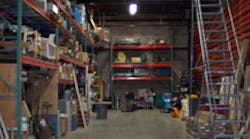With a student population of approximately 25,000, Colorado State University (CSU), Fort Collins, Colo., is dedicated to reducing its impact on the environment. The recently completed $30,000 retrofit of a campus warehouse's lighting system has taken the university one step closer to achieving this goal.
According to Cam Elvheim, project planner for CSU, the 38,225-square-foot warehouse is used to stock everyday items that must be readily dispensed, such as paper products, furniture, bedding, and mechanical/electrical supplies. In addition, the building houses numerous work cubicles for staff members. Needless to say, this sizable structure contains hundreds — if not thousands — of storage shelves. So when new fire safety rules mandated that the shelving units be reconfigured to meet code, a number of problems arose.
“In order to accommodate storing the same amount of items, the new shelving had to be taller,” says Elvheim. “This resulted in the 400W HID fixtures occasionally taking hits from the forklift. The different arrangement of the taller shelves also blocked much of their light, making the aisles dim. In short, these changes to the space were not only impeding staff efforts to provide excellent customer service, but also causing safety hazards.”
Elvheim says the challenge was to find an energy-efficient lighting system that was affordable to install, inexpensive to maintain, and provided quality lighting for warehouse workers. With assistance from the City of Fort Collins and local utility provider Platte River Power Authority, CSU came up with a solution that benefited both the college and surrounding community.
“Because this project significantly reduces energy use during peak times — which, in the long run, helps reduce the need to build an additional power plant — we received $13,945 in incentive money from Platte River Power Authority,” says Elvheim.
The project team also worked with Denver-based Colorado Lighting to find a high-performance fluorescent fixture that featured a quick warm-up time, could assist in the reading of small print, and would provide glare reduction for computer use. The system chosen uses 217W bulbs and incorporates motion detectors to control lights based on specific area usage.
According to Elvheim, what makes this project particularly progressive is the way in which it was implemented. “We started this yearlong project with a demonstration area, that gave staff the opportunity to visit the space, see how it worked, and ask questions,” she says. “Because the technology is new, there were concerns from previous installations where the motion sensors turned the lights off while they were working and the lamps strobed, flickered, or produced glare. The staff was able to see how the new fixtures would improve the work space, so we had a ‘buy in’ from the start.”



